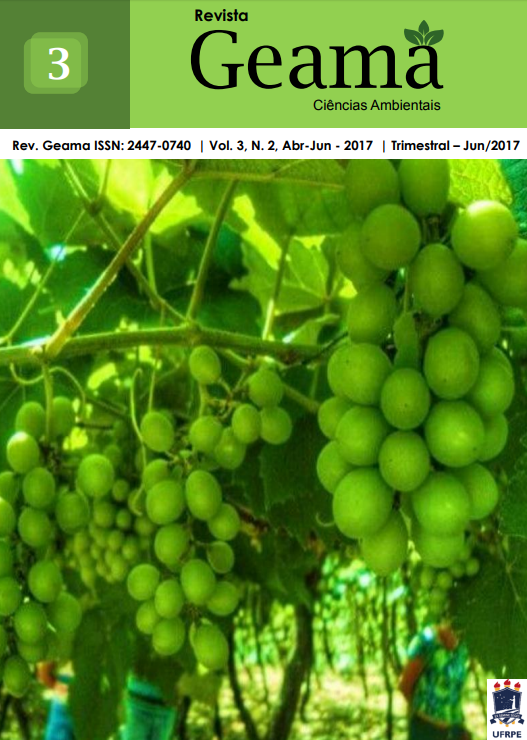Entomophagy in different food cultures | Entomofagia em diferentes culturas alimentares
Keywords:
Insect, Alimentation, Alternative foodAbstract
The entomophagy understands the consumption of insects for the human beings. In spite of exotic appearance it is practiced enough in many countries, mainly in Asia, Africa and Latin America, contributing so to the food security and models of subsistence. In Brazil, in special, in the northeast region the insects are food resources of considerable importance, because of being abundant, of easy collection and offer of nutritious ones. The objective of this inquiry valued the knowledge and the intention of practicing the entomofagia near the students of courses made a list to the extent of the food, located in the Metropolitan Region of Recife and Zona da Mata de Pernambuco. It was observed that most of the interviewed already have the habit in the consumption of ants (Tanajura), in the perspective of the maintenance and cultural tradition of the northeastern one. For 82,4 % of the interviewed ones, in spite of informing that the insects are not composing the usual diet, these showed the thought of including the entomophagy in the food, since they understand like a protein quality alternative.Downloads
References
ALVES, R. R. N.; ROSA, I. L.; SANTANA, G. G. The Role of Animal-derived Remedies as Complementary Medicine in Brazil. BioScience, Uberlândia. v. 57, n. 11, p. 949-955, 2007.
BERENBAUM, May R. A Consuming Passion for Entomophagy. American Entomologist, v. 62, n. 3, p. 140-142, 2016.
CARRERA, M. Terapêutica entomológica. Revista Brasileira de Entomologia, Curitiba, v. 37, n. 1, p. 193-198, 1992.
CHEN Y. Ants used as food and medicine in Chine. The Food Insects Newsletter, Madson, v. 7, n. 2, p. 1-10, 1994.
CHEUNG, T. L.; MORAES, Marília Soares. Inovação no setor de alimentos: insetos para consumo humano. Interações (Campo Grande), v. 17, n. 3, p. 503-515, 2016.
COIMBRA-JÚNIOR CEA, SANTOS RV (1993) Bicudo das palmáceas: praga ou alimento? Ciência Hoje 16(95): 59-6.
DUFOUR, D. L. Insect as food: a case study from the northwest Amazon. American Anthropologist, Arlington, v. 89, p. 383-397, 1987.
DWYER, P.; MINNEGAL, M. Hunting and harvesting: the pursuit of animals by Kubo of Papua New Guinea. In: PAWLEW, A. (Ed.) Man and a half: essays in Pacific zanthropology and ethnobiology in honour of Ralph Bulmer. Auckland: The Polynesian Society 1991. p. 86-95.
FAO. Food and Agriculture e Organization of the United Nations . Edible Insects: a solution for food and feed security, 2013.
LATHAN, P. Edible caterpillars of the Bas Congo region of the Democratic Republic of Congo. Antenna. Congo, v. 23, p. 134-139, 1999.
LENKO, K.; PAPAVERO, N. Os insetos no folclore. São Paulo: Plêiade, 1996. 468 p. Institute for Aboriginal Development. 1996. 70 p.
LENKO. K.;PAPAVERO, NELSON, S.:”o rei do Brasil”.In:SIMPÓSIO SOBRE FORMIGAS CORTADEIRAS DOS PAÍSES DO MERCOSUL,1998.p.39-45, Piracicaba.
MAIOR, M. S. Comes e Bebes do Nordeste. Recife: Fundação Joaquim Nabuco, 2012.
MENA, A. J. A. Medicina Indígena na Mesoamérica. Recife: Joaquim Nabuco, 2011. 416p.
MILLER Jr., G. T. Ciência Ambiental. São Paulo: Cengage Learning, 2014.
PEMBERTON, R. W. Catching and eating dragonflies in Bali and elsewhere in Asia. American Entomologist, Nova York, v. 41, p. 97-99, 1995.
POSEY, D. A. Etnoentomologia de tribos indígenas da Amazônia. In: RIBEIRO D. (Ed.) Suma Etnológica Brasileira, v. 1, Etnobiologia. Petrópolis: Vozes. 1986. p. 251- 271.
RAMOS-ELORDUY (2000) La etnoentomología actual en México en la alimentación humana, en la medicina tradicional y en la reciclaje y alimentación animal. Memorias del 35º Congreso Nacional de Entomología. pp. 3-46.
RAMOS-ELORDUY J.; PINO, J. M. M. El consumo de insectos entre los Aztecas. In: LONG, J. (Ed.). Conquista y comida. Consecuenciasdel encuentro de dos mundos. México: UNAM. 1996. p. 89-101.
RAMOS-ELORDUY, J., Moreno, J. M. P., Prado, E. E., Perez, M. A., Otero, J. L., and O. Ladron De Guevara. 1998. Nutritional Value of Edible Insects from the State of Oaxaca, Mexico. Journal of Food Composition and Analysis 10: 142-157.
SUTTON, M. Q. Aboriginal Tasmanian entomophagy. In: INTERNATIONAL CONGRESS OF ETHNOBIOLOGY, 1., 1988, Belém. Ethnobiology: Implications and applications, Belém: MPEG, 1988. p. 209-217.
TAN, H. S. G.; VERBAAN, Y. T.; STIEGER, M. How will better products improve the sensory-liking and willingness to buy insect-based foods?. Food Research International, v. 92, p. 95-105, 2017.
TURNER, M.M. Bush foods: Arrernte foods from Central Australia. Austrália: IAD Press.






